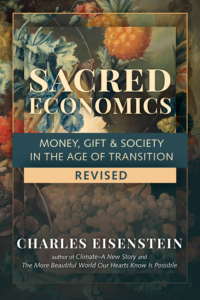Climate — A New Story
Chapters
Chapter 5: Carbon: The Ecosystems View
The Geoengineering Delusion
From the standard carbon perspective, the world faces a grim future. The necessary drastic cuts in emissions are impossible to accomplish in time to avoid catastrophe. Many climate scientists conclude that the only practical solution is what is known as “geoengineering”—the artificial altering of the atmospheric composition and surface reflectivity of the planet in order to reduce global temperatures. The three most-researched technologies involve dumping large amounts of iron oxide into the oceans in order to absorb and store carbon dioxide, spraying sulfate aerosols into the atmosphere to increase the planet’s albedo (reflectivity), and installing millions of carbon-sucking machines to remove CO2 from the air.
While many scientists (particularly those with an orientation toward systems theory) are highly skeptical of these proposals, mainstream organizations like the U.S. National Research Council have endorsed their development. Possibly, some of these technologies are already being secretly tested through what some people refer to as “chemtrails.” I am skeptical of many of the theories advanced by chemtrail researchers, particularly those involving deliberate attempts to sicken the population, but aerial spraying programs are entirely plausible from the geoengineering mindset of climate modification and weather control.[20]
Geoengineering has also attracted widespread mainstream criticism for possible unintended consequences such as ozone depletion, ocean acidification, and reduced rainfall in the tropics. Ecologists are especially concerned. Considering the havoc wreaked by the introduction of a single new species like rabbits in Australia, imagine what the nonlinear knock-on effects might be of wholesale changes to oceanic or atmospheric chemistry. Such geoengineering proposals are attractive only from the perspective of the engineer managing a machine.
I’m especially troubled by sulfate aerosol spraying, which would essentially bleach the sky to a lighter shade of blue. Once we start bleaching the sky to reduce temperature, we won’t easily be able to stop, because stopping would induce a very sudden temperature rise. Unless the spraying coincided with strong measures to reduce greenhouse gases (or, in my view, restore ecosystems), it would have to continue indefinitely.
This concern exemplifies a more general problem with geoengineering. If the living planet view I’ve described is correct, then these cooling measures will allow the real problem to continue unabated. Thinking we have solved the problem, we will be able to proceed with ecosystem destruction, covering up the symptom while worsening the disease. Taking for granted carbon as a proxy for biospheric health, we will be less able to hear the cries of the earth over the hum of the carbon-sucking machines.
Hey, I’ve got a good idea. With machines to suck carbon and algae pools to make oxygen, maybe someday we can dispense with nature entirely. Maybe someday we can replace every natural and wild thing with artificial substitutes. Hydroponic solutions can replace soil, water filtration machines can replace wetlands, vat-grown meat can replace livestock. We can fine-tune greenhouse gas levels to create just the right temperature. The conquest of nature will be complete.
What scares me the most is not that this is a vain fantasy doomed to failure. What scares me is that we will succeed.
There is a second category of geoengineering that uses life, rather than chemicals, as its instrument. It is a step toward the understanding that life creates the conditions for life, yet mechanistic and reductionistic mindsets still encroach in its application.
For example, the growing understanding of forest carbon storage has birthed schemes for massive, rapid reforestation through drone planting of trees. The numbers look good: more trees means less carbon dioxide.
We must remember though that a forest is more than a concentration of trees. While planting by drone allows a rate of reforestation ten or a hundred times that of human tree planting, it is necessarily less sensitive to unique local conditions. These conditions may to an extent be encompassed by data on soil, microclimate, and so forth, but that data will leave a lot out. Only people who have been in long, closely observant relationship to the land—ideally a multigenerational relationship—can possibly know exactly what to plant to grow a living forest. Without this knowledge, reforestation efforts often fail or exacerbate the problems they were meant to solve. The best known case is in China, where the “Great Green Wall” of trees planted to stop desertification seemed to work initially, as the trees tapped into deep soil moisture. Eventually, in some places these water-thirsty trees used up available water and died. Before that happened, their leaf canopy shut out light to the original grasses and other vegetation that grew there, exposing soil to the very erosion they were planted to prevent.[21]
The lesson here is that what works in one place may not work somewhere else. Top-down solutions are necessarily based on simplifying assumptions and standardized, scalable measures. We must turn away from an attitude of nature-as-engineering-object to one of humble partnership. Whereas geoengineering is a global solution that feeds the logic of centralization and the economics of globalism, regeneration of soil and forests is fundamentally local: forest by forest, farm by farm. There are no standard solutions, because the requirements of the land are unique to each place. Unsurprisingly, they are typically more labor-intensive than conventional practices, because they require a direct, intimate relationship to the land. Ultimately, no geoengineering scheme that fails to bring us back to intimate relationship is going to work. Tree planting should be a first step in tree caring, tree partnership, tree relationship. This would require millions of people, and not just a fleet of drones, to enter the field of forest care. Is that such a bad thing?
Wait, do I hear a voice saying, “Yes, yes, in the long run we need to do these things, but right now we have to act globally and act fast. The slow work of healing ecosystems is not enough, because without immediate global action to dramatically cut emissions, we will pass the tipping point into irreversible self-reinforcing climate catastrophe.” As always, the long term is sacrificed to the short term, and the responses that fit most easily into the status quo are prioritized over those that do not. When we call for quick action, we further empower those already in power, who have the wherewithal to act swiftly and globally. And because the crises are unrelenting and the solutions are superficial, the long term never comes. We just end up giving more power to the same political elites, centralized bureaucracies, and general political system that is inextricably wedded to the current regime of ecocide.
The real problem with the above objection though is that the climate benefits of restoration and regeneration are not slow at all, a fact that will become even more clear when I discuss regenerative agriculture. Remember, I have proclaimed myself an alarmist. The time is now to align civilization with ecology. But how do we do that, without in our haste falling into patterns of response that intensify the problem?
Ultimately, climate change is challenging us to rethink our long-standing posture of separation from nature, in which we think we can endlessly engineer our way out of the damage we have caused. It is calling us back to our biophilia, our love of nature and of life, our desire to care for all beings whether or not they make the greenhouse gas numbers go up or down. Geoengineering, beyond its catastrophic risks, is an attempt to avoid that call, to extend the mindset of domination and control to new extremes, and to prolong an economy of overconsumption a few years longer. Eileen Crist puts it this way:
Even if they work exactly as hoped, geoengineering solutions are far more similar to anthropogenic climate change than they are a counterforce to it: their implementation constitutes an experiment with the biosphere underpinned by technological arrogance, unwillingness to question or limit consumer society, and a sense of entitlement to transmogrifying the planet that boggles the mind. It is indeed these elements of techno-arrogance, unwillingness to advocate radical change, and unlimited entitlement, together with the profound erosion of awe toward the planet that evolved life (and birthed us), that constitute the apocalypse underway—if that is the word of choice, though the words humanization, colonization, or occupation of the biosphere are far more descriptively accurate.[22]
From the mindset of the Technological Program (to perfect human control of nature), a more detailed understanding of cloud formation and rainfall leads immediately to the desire to engineer cloud formation and control precipitation. Surely we can improve on the random processes of nature! That mindset says, “When we finally understand the workings of nature on a fine enough scale, we will be able to effectively control it.” To manage a complicated (as opposed to a complex) system, the first priority is to understand each of the variables. When we’ve quantified all the causal relationships among them, then we will know how to control the results. This is akin to the belief that when we understand the minute cellular and genetic processes that constitute human physiology, we will be able to conquer disease with specifically targeted medicines. More generally, the holy grail of science has been complete control of reality through its complete reductionistic understanding built atop a “theory of everything.”
Whether in the area of ecology or human health, we are now learning the hard way that better reductionistic understanding of a complex system does not necessarily bring about better control of that system. Understanding of the molecular machinery of cellular function has (judging by the volume of scientific papers) increased exponentially over the past half-century, yet it has borne nothing by way of the long-promised “targeted” medicines to cure cancer and the new wave of autoimmune diseases. The basic (conventional, that is) treatments are much the same as they were in the 1970s, using blunt chemical, surgical, or radiological force to kill the cancer or override the immune system. A parallel in the environmental realm has been the failure of targeted extermination efforts to repel invasive species. Nor have precision “smart bombs” and “surgical strikes” made war any more effective in achieving its stated goals.
Now I am not saying that there is never a time to surgically remove a cancer, wipe out an infection with antibiotics, or suppress an invasive species. There is, in life, sometimes the occasion for a fight. Fighting is not the problem; the problem is the habit of fighting, motivated by an inaccurate worldview that rushes to find an enemy to blame. More generally, the problem is not top-down control-based responses; the problem is to default to these responses due to incomprehension of complex, living systems. We then become lost in a maze of unintended consequences, twisting and turning from one emergency to another, haplessly creating the next emergency with our response to the previous. Each solution worsens the crisis it is supposed to solve.
What, then, are we supposed to do? It is fine to exhort environmentalists and policymakers to adopt systems thinking, but frankly, whole-systems thinking is something that we (collectively) really don’t know how to do. Our systems are not geared for it, nor our habits of thought, nor our social, financial, and epistemological infrastructure. Our primary modes of problem-solving and knowledge production are fundamentally incompatible with healthy participation in complex living systems. This presents nothing less than a civilizational crisis. That is why climate change is a rite of passage for humanity, an initiatory ordeal. The failure of our customary ways of applying power to address the ecological crisis will graduate us into a new and ancient way of engaging the world. This new and ancient way is already visible in the margins of civilization—in indigenous and peasant cultures, and in much of what we call alternative or holistic. What it lacks, besides a sufficiently broad culture of practice, is a unifying narrative.
End Notes
[20] I won’t go into the debate here—if you are interested you can watch the documentary Overcast. I am agnostic on the issue, although I have seen some odd things, such as a jet leaving an intermittent contrail in mechanically regular two-second bursts across the entire sky. Maybe it was going through alternating zones of different humidity, but the precise regularity of the dashed line it made across the sky was suspicious.
[21] Luoma (2012).
[22] Crist (2007).






